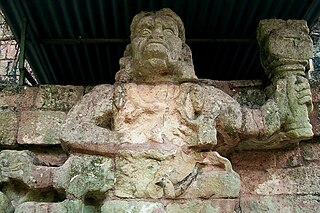
Copán is an archaeological site of the Maya civilization in the Copán Department of western Honduras, not far from the border with Guatemala. This ancient Maya city mirrors the beauty of the physical landscape in which it flourished—a fertile, well-watered mountain valley in western Honduras at an elevation of 600 meters above mean sea level. It was the capital city of a major Classic period kingdom from the 5th to 9th centuries AD. The city was in the extreme southeast of the Mesoamerican cultural region, on the frontier with the Isthmo-Colombian cultural region, and was almost surrounded by non-Maya peoples.
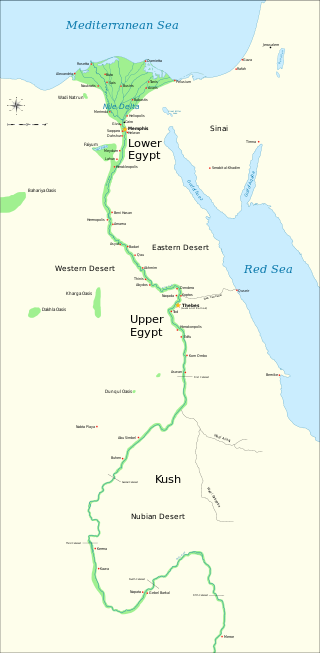
The First Intermediate Period, described as a 'dark period' in ancient Egyptian history, spanned approximately 125 years, c. 2181–2055 BC, after the end of the Old Kingdom. It comprises the Seventh, Eighth, Ninth, Tenth, and part of the Eleventh Dynasties. The concept of a "First Intermediate Period" was coined in 1926 by Egyptologists Georg Steindorff and Henri Frankfort.
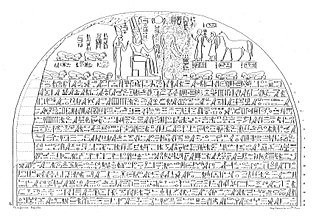
Piye was an ancient Kushite king and founder of the Twenty-fifth Dynasty of Egypt, who ruled Egypt from 744–714 BC. He ruled from the city of Napata, located deep in Nubia, modern-day Sudan.

Userkhaure-setepenre Setnakhte was the first pharaoh (1189 BC–1186 BC) of the Twentieth Dynasty of the New Kingdom of Egypt and the father of Ramesses III.
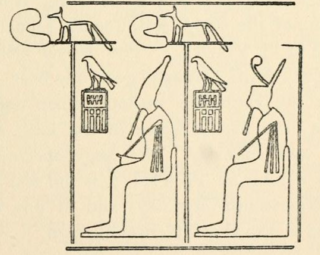
Djer is considered the third pharaoh of the First Dynasty of ancient Egypt in current Egyptology. He lived around the mid-thirty-first century BC and reigned for c. 40 years. A mummified forearm of Djer or his wife was discovered by Flinders Petrie, but was discarded by Émile Brugsch.

Userkare Khendjer was the twenty-first pharaoh of the Thirteenth Dynasty of Egypt during the Second Intermediate Period. Khendjer possibly reigned for four to five years, archaeological attestations show that he was on the throne for at least three or four years three months and five days. Khendjer had a small pyramid built for himself in Saqqara and it is therefore likely that his capital was in Memphis.

Shepsesre Tefnakht was a prince of Sais and founder of the relatively short Twenty-fourth Dynasty of Egypt; he rose to become a Chief of the Ma in his home city. He is thought to have reigned roughly 732 BCE to 725 BCE, or seven years. Tefnakht I first began his career as the "Great Chief of the West" and Prince of Sais and was a late contemporary of the last ruler of the 22nd Dynasty: Shoshenq V. Tefnakht I was actually the second ruler of Sais; he was preceded by Osorkon C, who is attested by several documents mentioning him as this city's Chief of the Ma and Army Leader, according to Kenneth Kitchen, while his predecessor as Great Chief of the West was a man named Ankhhor. A recently discovered statue, dedicated by Tefnakht I to Amun-Re, reveals important details about his personal origins. The statue's text states that Tefnakht was the son of a certain Gemnefsutkapu and the grandson of Basa, a priest of Amun near Sais. Consequently, Tefnakht was not actually descended from either lines of Chiefs of the Ma and of the Libu as traditionally believed but rather came from a family of priests, and his ancestors being more likely Egyptians rather than Libyans.

Senakhtenre Ahmose, was the seventh king of the Seventeenth Dynasty of Egypt during the Second Intermediate Period. Senakhtenre reigned for a short period over the Theban region in Upper Egypt at a time where the Hyksos 15th Dynasty ruled Lower Egypt. Senakhtenre died c.1560 or 1558 BC at the latest.
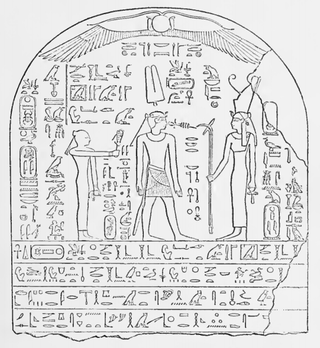
Menkheperre Ini was an Egyptian king reigning at Thebes during the 8th century BC following the last king of the 23rd Dynasty, Rudamun.

Usermaatre Setepenamun Takelot III Si-Ese was Osorkon III's eldest son and successor. Takelot III ruled the first five years of his reign in a coregency with his father, according to the evidence from Nile Quay Text No.13, and succeeded his father as king the following year. He served previously as the High Priest of Amun at Thebes. He was previously thought to have ruled Egypt for only 7 years until his 13th Year was found on a stela from Ahmeida in the Dakhla Oasis in 2005.

Sekhemre Seusertawy Sobekhotep VIII was possibly the third king of the 16th Dynasty of Egypt reigning over the Theban region in Upper Egypt during the Second Intermediate Period. Alternatively, he may be a ruler of the 13th or 17th Dynasty. If he was a king of the 16th Dynasty, Sobekhotep VIII would be credited 16 years of reign by the Turin canon, starting c. 1650 BC, at the time of the Hyksos invasion of Egypt.
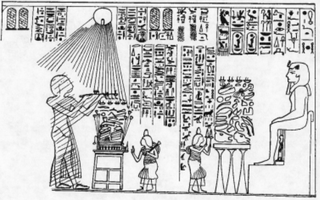
Bek or Bak was the first chief royal sculptor during the reign of Pharaoh Akhenaten. His father Men held the same position under Akhenaten's father Amenhotep III; his mother Roi was a woman from Heliopolis.
Seti or Suti was an ancient Egyptian soldier during the late 18th Dynasty, the commander of the army, later mentioned as vizier on monuments of his son, Pharaoh Ramesses I.
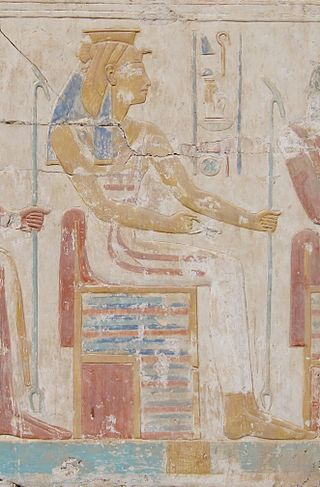
Heqet, sometimes spelled Heket, is an Egyptian goddess of fertility, identified with Hathor, represented in the form of a frog. To the Egyptians, the frog was an ancient symbol of fertility, related to the annual flooding of the Nile. Heqet was originally the female counterpart of Khnum, or the wife of Khnum by whom she became the mother of Her-ur. It has been proposed that her name is the origin of the name of Hecate, the Greek goddess of witchcraft.
Nefer-Setekh is the name of an ancient Egyptian high official, who lived and worked either during the late midst of the 2nd or during the beginning of the 3rd dynasty. He became known by his name, which was addressed to the deity Seth.

Sehener was an ancient Egyptian princess living during the late 2nd Dynasty. It is disputed as to who was the king (pharaoh) that reigned during Sehener's lifetime.
Khenmetptah was an ancient Egyptian king's daughter who lived most likely in the Second Dynasty. She is only known from her stela once placed in her tomb and found at Helwan. On the stela Khenmetptah is shown sitting on a chair in front of an offering table. Next to the offering table are shown many offerings. Above this scene is a short text: the king's daughter Khenmetptah. Her royal father is not known. On stylistical grounds the stela is datable to the Second Dynasty.
Satkhnum was an ancient Egyptian king's daughter who lived most likely in the Second Dynasty. She is only known from her stela once placed in her tomb and found at Helwan. On the stela Satkhnum is shown sitting on a chair in front of an offering table. Next to the offering table are shown many offerings. Above this scene is a short text: Satkhnum, the king's daughter. Her royal father is not known. On stylistical grounds the stela is datable to the Second Dynasty.
At Helwan south of modern Cairo was excavated a large ancient Egyptian cemetery with more than 10.000 burials. The cemetery was in use from the Naqada Period around 3200 BC to the Fourth Dynasty and again at the beginning of the Middle Kingdom and then up to the Roman Period and beyond. The burial ground was discovered and excavated by Zaki Saad in 1942 to 1954. Further excavations started in 1997 by an Australian expedition. The excavations of Zaki Saad were never fully published, only several preliminary reports appeared. Helwan was most likely the cemetery of Memphis in the first Dynasties. The tombs range from small pits to bigger elaborated mastabas. Regarding the underground parts of these tombs, two types are attested. There are on one side pits with the burial at the bottom and there are on the other side underground chambers, reached via a pit or via a staircase. The majority of burials are for one deceased.
Meriiti was an ancient Egyptian official living at the end of the First Dynasty around 2900 BC. He is only known from his stela found in tomb 810.H.11 at Helwan. The stela was found in the burial chamber next to the coffin. It shows on the left Meriiti sitting on a chair with offerings in front of him. On the right side of the stela is a list of Meriiti's titles.














